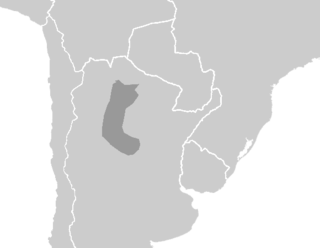Related Research Articles
The Alacalufan languages or Kawesqaran languages are a small language family of South America. They have not been definitely linked to any other American language family.

The Borôroan languages of Brazil are Borôro and the extinct Umotína and Otuke. They are sometimes considered to form part of the proposed Macro-Jê language family, though this has been disputed.
The Araucanian languages are a small language family of indigenous languages of the Americas spoken in central Chile and neighboring areas of Argentina. The living representatives of this family are Mapudungun and Huilliche, spoken respectively by the Mapuche and Huilliche people. These are sometimes considered divergent dialects of a single language isolate.

The Maxakalían languages were first classified into the Jê languages. It was only in 1931 that Čestmír Loukotka separated them from the Jê family. Alfred Métraux and Curt Nimuendajú considered the Maxakalían family isolated from others. John Alden Mason suggests a connection with the Macro-Jê stock, confirmed by Aryon Rodrigues.

Munichi is a recently extinct language which was spoken in the village of Munichis, about 10 miles (16 km) west of Yurimaguas, Loreto Region, Peru. In 1988, there were two mother-tongue speakers, but they had not met since the 1970s. The last known fluent speaker, Victoria Huancho Icahuate, died in the late 1990s. As of 2009 there were several semi-speakers who retained significant lexical, and partial grammatical, knowledge of the language.

The Chicham languages, also known as Jivaroan is a small language family of northern Peru and eastern Ecuador.
Matacoan is a language family of northern Argentina, western Paraguay, and southeastern Bolivia.
Chimuan or Yuncan is a hypothetical small extinct language family of northern Peru and Ecuador.
The Aguano are a people of Peru. In 1959, they consisted of 40 families. They inhabit the lower Huallaga and upper Samiria Rivers, and the right bank tributary of the Marañon River.
Chamicuro is a dormant South American language formerly spoken in Peru. The language was used by the Chamicuro people who were around one hundred people. The Chamicuros live on a tributary of the Huallaga river, in Peru, in an area called Pampa Hermosa, meaning beautiful plains.
Katukinan (Catuquinan) is a language family consisting of two languages in Brazil, Katukina-Kanamarí and the perhaps moribund Katawixi. It is often not clear which names in the literature, which are generally tribal names and often correspond to dialects, refer to distinct languages. Indeed, they're close enough that some consider them all to be dialects of a single language, Kanamari.

The Jirajaran languages are group of extinct languages once spoken in western Venezuela in the regions of Falcón and Lara. All of the Jirajaran languages appear to have become extinct in the early 20th century.

The two Lule–Vilela languages constitute a small, distantly related language family of northern Argentina. Kaufman found the relationship likely and with general agreement among the major classifiers of South American languages. Viegas Barros published additional evidence from 1996–2006. However, Zamponi (2008) considers Lule and Vilela each as language isolates, with similarities being due to contact.
Witotoan is a small language family of southwestern Colombia and the neighbouring region of Peru.

The Nambikwaran languages are a language family of half a dozen languages, all spoken in the state of Mato Grosso in Brazil. They have traditionally been considered dialects of a single language, but at least three of them are mutually unintelligible.

The Kamakã languages are a small family of extinct Macro-Jê languages of Bahía, northeastern Brazil. The attested Kamakã languages are:

Huarpe (Warpe) was a small language family of central Argentina that consisted of two closely related languages. They are traditionally considered dialects, and include Allentiac and Millcayac (Milykayak). A third, Puntano of San Luis, was not documented before the languages became extinct.
Chimané (Tsimané) is a South American language isolate. Some dialects are known as Mosetén. Chimane is a language of the western Bolivian lowlands spoken by the Tsimane peoples along the Beni River and the region around San Borja in the Department of Beni (Bolivia). Sakel (2004) classifies them as two languages for a number of reasons, yet some of the variants of the language are mutually intelligible and they reportedly have no trouble communicating and were evidently a single language separated recently through cultural contact.

Otuke is an extinct language of the Macro-Jê family, related to Bororo. Otuke territory included what is now the Otuquis National Park and Integrated Management Natural Area in eastern Bolivia.
Ingain is an extinct Jê language of Brazil, closely related to the Southern Jê languages Kaingáng and Laklãnõ (Xokléng). Kimdá may have been a dialect. Ingain was spoken along the middle Paraná River, from the Iguatemi River in the north to the Arroyo Yabebiry in the south.
References
- 1 2 Aguano at Ethnologue (24th ed., 2021)

- ↑ Loukotka, Čestmír (1968). Classification of South American Indian languages . Los Angeles: UCLA Latin American Center.
- ↑ Mason, J. Alden. 1950. The languages of South America. In: Julian Steward (ed.), Handbook of South American Indians, Volume 6, 157–317. (Smithsonian Institution, Bureau of American Ethnology Bulletin 143.) Washington, D.C.: Government Printing Office.